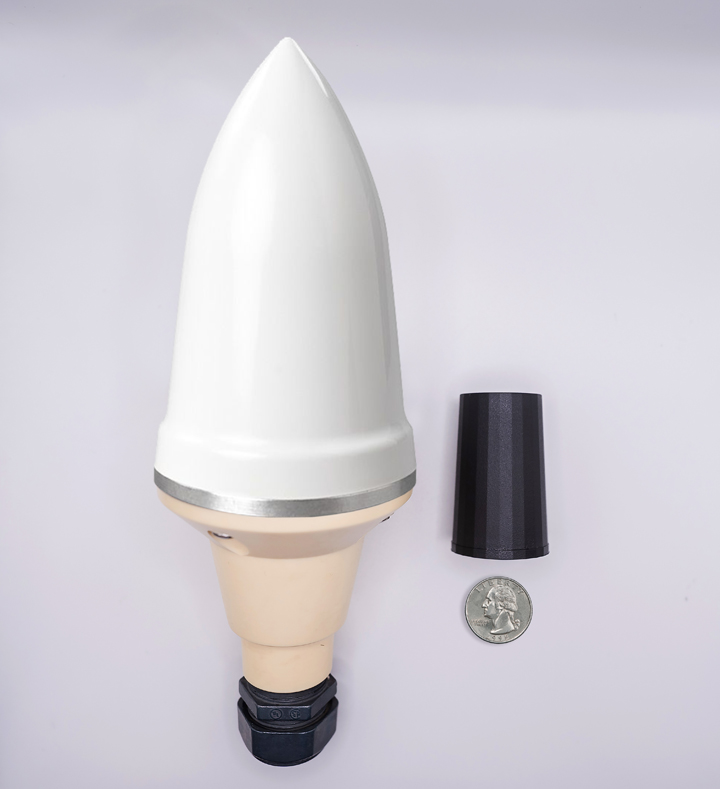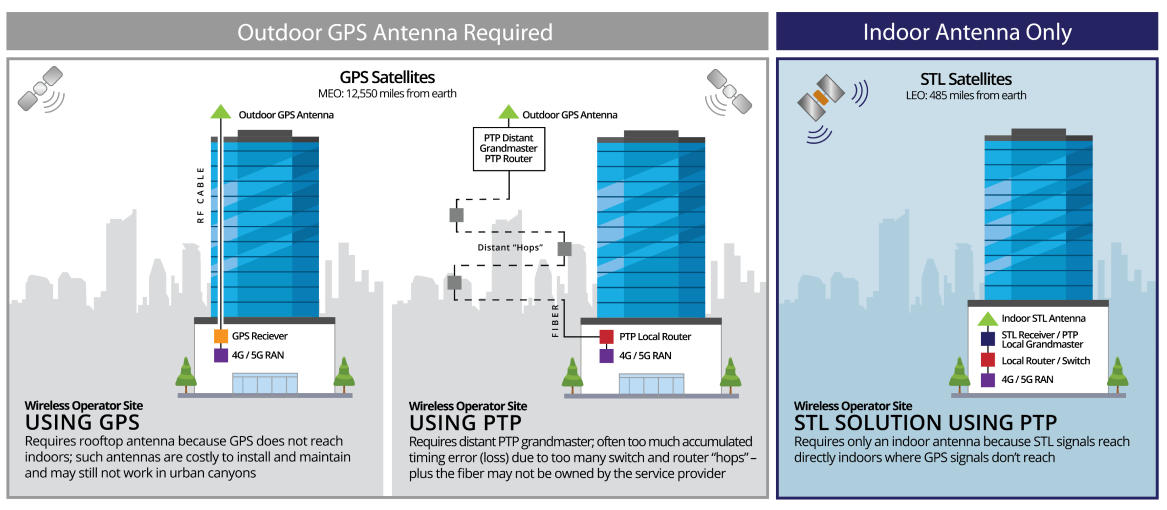STL is a Stratum 0 UTC source of time that can be used to create a Stratum 1 timing clock compliant with the ITU-T G.8272 PRTC-A performance standard. It’s ideal for the type of precision timing that carriers demand.
What is the Challenge?
Wireless carriers rely on timing in all aspects of their networks — but timing synchronization challenges are disrupting and delaying 5G network rollouts and deployments. Failed installations and repeat technician visits are all too common due to indoor equipment requiring an outdoor GPS antenna installation.
For example, a 5G Radio Access Network (RAN) utilizes five to ten times increased network densification compared to 4G. And many of these nodes are located indoors where Global Navigation Satellite Systems (GNSS) like GPS and Galileo do not work without an outdoor antenna.
Synchronizing these locations is complicated, and standalone precision time protocol (PTP) systems do not always deliver the accuracy required, especially when TDD is deployed.
That’s where STL comes in.
Timing Synchronization is Everything in 5G Networks
Learn More
Common Struggles of 5G Carriers
Engineering and operations personnel from wireless carriers know all too well how things can go wrong when trying to use GNSS for timing synchronization. Some typical examples:
- Fighting to obtain landlord permissions for roof rights to install a GNSS antenna — and then obtaining it after great effort only to have to pay exorbitant one-time or ongoing fees to keep the antenna on the roof.
- Dealing with the hassle and expense of coring through multiple floors of a high-rise building to gain access to the roof to run the cabling for a GNSS antenna.
- Suffering from the delays and unpredictability of 5G roll-outs due to the time it takes to get permissions for roof rights and to coordinate the schedules of installers.
- Grappling with signal multipath and other problems that prevent GNSS from working — even with an outdoor antenna.
- Enduring repeat alarms and initiating multiple truck rolls because of GPS bouncing.
If these problems sound familiar, then it’s time to consider a timing solution from Satelles. STL is easy to connect and simple to configure, it operates with a very small indoor antenna and in occluded environments, and it just works.
STL is the Solution
With STL, installations are completed quickly and easily, the first time — saving time and money. STL delivers precise time synchronization and indoor coverage where GNSS doesn’t reach.
Receivers capable of receiving STL using only indoor antennas are being implemented by wireless carriers today at 4G and 5G RAN sites — meeting 3GPP requirements.
For example, an STL-synchronized device located indoors can be connected to the wireless carrier’s local router enabling 5G to work indoors — without an outdoor antenna:

Why STL is Perfect for 5G
Reliable Timing
Indoor Coverage
STL can provide timing synchronization with an indoor antenna in environments where distributed PTP is unable to provide needed accuracy when and where GNSS is not available. That’s essential when outdoor GNSS antennas are impractical to install or not permitted.
Survivability and Resilience
STL ensures survivability and resilience by serving as an essential contingency or backup capability to protect the operations of PNT-dependent systems when GNSS isn’t available. It’s always on, always available.
Satelles STL Systems Meet 5G Wireless Needs
Satelles works with partners to manufacture a portfolio of STL-capable products. Multi-feature receivers connect to wireless operators’ RAN gear or routers, providing timing sync whenever and wherever GNSS is unavailable.
All Satelles STL systems have diverse operational characteristics, performance specifications, and price points to solve some of 5Gs largest challenges – and meet wireless carriers’ biggest needs.

Get the Specifics
- Watch our one-minute video for a quick overview of STL
- Check out our brochure for more information about Satelles timing synchronization solutions for 5G
- Download our data sheet for our system specifications, including stability of 20 to 100 nanoseconds and timing traceable to UTC(USNO) and UTC(NIST)
- Learn about wireless market recognition for STL in the 2022 Fierce Wireless Awards and 2023 Small Cell Forum Industry Awards
Did you know?
Government authorities in the U.S. (NIST, DHS, DOT) and Europe have subjected STL to rigorous testing and thorough evaluations. They confirmed timing accuracy specifications to UTC and validated the operational characteristics of STL such as indoor signal reception, resilience in the event of a GNSS outage, and worldwide availability.
Let's Talk!
Contact us to learn more about how Satelles can help you meet your 5G wireless needs.
Contact Us